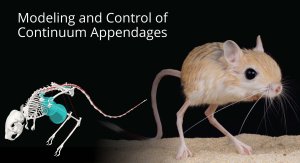
Co-chairs: Talia Moore and Ram Vasudevan
Abstract:
Appendages such as arms, legs, fins, wings, and tails are external body parts attached to an organism’s main body, playing essential roles in animal locomotion. Tails, found in most vertebrates, are particularly versatile, serving a wide range of functions such as providing stability, maneuverability, and prehension. Inspired by these functions, researchers have been integrating tail-like appendages into robotic designs to enhance robot movement, demonstrating significant improvements in control, stability, and efficiency.
However, current studies often simplify animal tails to a single rigid link. While this simplification streamlines the modeling and control of tail-like appendages, it might overlook the potential impacts of having more articulated tails, raising questions about the insights that might be missed by this "reductionist" approach.
Improved models, which incorporate the detailed structure of animal tails, offer a more in-depth approach to uncovering the biological principles of the tail’s contributions to animal locomotion, particularly those of high performance which people have a keen interest in. These models can influence the design of bio-inspired robots. Additionally, they hold the potential to guide researchers toward more informative and appropriate simplified models that might not solely consist of a single rigid link. However, while holding considerable value for advancing both biological understanding and robotic research, these improved models exhibit much greater complexity. This renders the analysis and control of them computationally challenging. Hence, devising methods that alleviate the computational load in the analysis and control of complex systems, while still retaining a high degree of accuracy in the depiction of their dynamic behavior, is of paramount importance.
In light of these research gaps, to explore valuable insights into the underlying role of tails in animal movement, this dissertation constructs improved tail models to examine the superior maneuverability afforded by articulated tails over single rigid links and other inertial appendages. We introduce a specialized software framework for constructing musculoskeletal models of biological articulated appendages, aiming for comprehensive musculoskeletal models of articulated tails. To tackle the difficulties faced in analyzing and controlling complex systems, such as articulated tails, this dissertation introduces a data-driven modeling and control framework for these systems. This method leverages Koopman operator theory to develop models that are both accurate and computationally efficient, enabling their integration into closed-loop optimal control schemes.
Zoom passcode: 602352
Abstract:
Appendages such as arms, legs, fins, wings, and tails are external body parts attached to an organism’s main body, playing essential roles in animal locomotion. Tails, found in most vertebrates, are particularly versatile, serving a wide range of functions such as providing stability, maneuverability, and prehension. Inspired by these functions, researchers have been integrating tail-like appendages into robotic designs to enhance robot movement, demonstrating significant improvements in control, stability, and efficiency.
However, current studies often simplify animal tails to a single rigid link. While this simplification streamlines the modeling and control of tail-like appendages, it might overlook the potential impacts of having more articulated tails, raising questions about the insights that might be missed by this "reductionist" approach.
Improved models, which incorporate the detailed structure of animal tails, offer a more in-depth approach to uncovering the biological principles of the tail’s contributions to animal locomotion, particularly those of high performance which people have a keen interest in. These models can influence the design of bio-inspired robots. Additionally, they hold the potential to guide researchers toward more informative and appropriate simplified models that might not solely consist of a single rigid link. However, while holding considerable value for advancing both biological understanding and robotic research, these improved models exhibit much greater complexity. This renders the analysis and control of them computationally challenging. Hence, devising methods that alleviate the computational load in the analysis and control of complex systems, while still retaining a high degree of accuracy in the depiction of their dynamic behavior, is of paramount importance.
In light of these research gaps, to explore valuable insights into the underlying role of tails in animal movement, this dissertation constructs improved tail models to examine the superior maneuverability afforded by articulated tails over single rigid links and other inertial appendages. We introduce a specialized software framework for constructing musculoskeletal models of biological articulated appendages, aiming for comprehensive musculoskeletal models of articulated tails. To tackle the difficulties faced in analyzing and controlling complex systems, such as articulated tails, this dissertation introduces a data-driven modeling and control framework for these systems. This method leverages Koopman operator theory to develop models that are both accurate and computationally efficient, enabling their integration into closed-loop optimal control schemes.
Zoom passcode: 602352